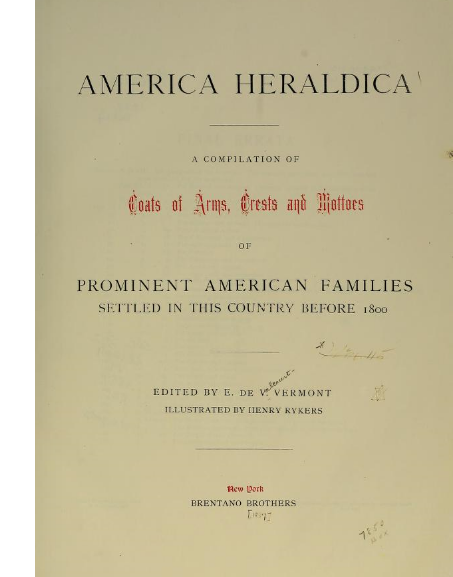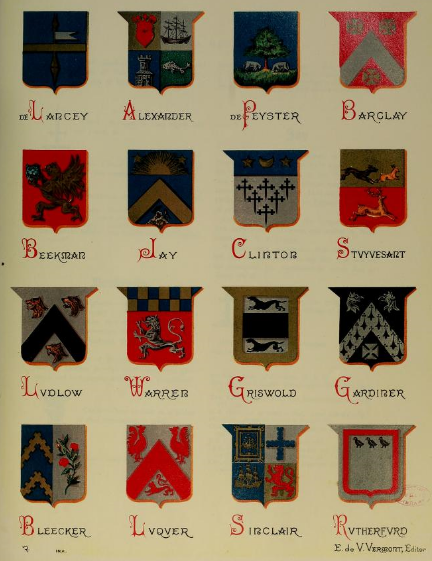 A review by Reverend Beverley R. Betts of E. de V. Vermont's America Heraldica appeared in The NYG&B Record, Vol. 18, No. 1 (January 1887). Betts’s main critique of the book lies in the loftiness of the goal that Vermont sets for himself: to create “a complete and final list of American families, emigrated before 1800, and having proved peremptorily their ancestral right to coat armor” (my italics). Not only is this task beyond Vermont’s ability, writes Betts, it is patently impossible, due to the fact that many of these eminent families cannot verify their descent from the original armigers. Instead, family members and genealogists have historically applied “conjectural pedigrees” and “untrustworthy … family traditions” in place of concrete evidence to make such verifications. In his attempt to “prove” these families’ “ancestral right[s],” Vermont uncritically reproduces genealogical errors and fantasies.
A review by Reverend Beverley R. Betts of E. de V. Vermont's America Heraldica appeared in The NYG&B Record, Vol. 18, No. 1 (January 1887). Betts’s main critique of the book lies in the loftiness of the goal that Vermont sets for himself: to create “a complete and final list of American families, emigrated before 1800, and having proved peremptorily their ancestral right to coat armor” (my italics). Not only is this task beyond Vermont’s ability, writes Betts, it is patently impossible, due to the fact that many of these eminent families cannot verify their descent from the original armigers. Instead, family members and genealogists have historically applied “conjectural pedigrees” and “untrustworthy … family traditions” in place of concrete evidence to make such verifications. In his attempt to “prove” these families’ “ancestral right[s],” Vermont uncritically reproduces genealogical errors and fantasies.
Such fantasies include the claims Vermont makes for the families of Washington, Lawrence, and Woodhull, whose “line of descent” from English armigers “has never been established." By Vermont’s own rules, these families should be excluded from America Heraldica. Additionally, while General William Alexander – the armiger of the Alexander arms depicted in Vermont’s book – did in fact settle in New York, he left no male descendants; thus no Alexander can claim direct paternal descent from him or the right to his arms.
My own research has uncovered other critics who have taken the claims made in America Heraldica into question. One article, “Some Doubts Concerning the Sears Pedigree,” was published by Samuel P. May in the 1886 New England Historical General Society Register, one year prior to the publication of America Heraldica. May’s “doubts” lie with the claims, published twenty years earlier by Sir Bernard Burke in “Notices of the Sears Family” and repeated by Vermont, that the immigrant Richard Sears (c.1610-1676) was the son of John Bourchier Sears and a Dutch woman of the Van Egmond family; that he was a descendant of John Sayers of Colchester; and, accordingly, that Richard and his descendants could claim the right to bear John Sayers’s arms.
According to May, the Old World lineage claimed for Richard Sears was a concoction devised to enhance the Sears family prestige. While Richard Sears’s actions in the New World are well documented, nothing can be definitively ascertained about his life prior to his immigration, including the identities of his parents and his place of origin. Burke admitted the inaccuracy of his claims as early as 1884, writing in a letter to May that “the details [of Richard Sears’s lineage] were not only not proven, but also incapable of proof."
As Betts writes, American heraldry is generally beset by the fact that many links between the Old and New Worlds are similarly “incapable of proof.” Either the necessary proof no longer exists, or it never did. Betts condemns Vermont for reproducing as fact the tenuous attempts of earlier authors to connect American families with English armigers in spite of a complete lack of evidence. In doing so, Betts says, Vermont is guilty of treating heraldry as less than what it is: “a science which, no less than mathematics, requires perfect accuracy."
 Surprisingly, Betts does not insist that Vermont omit from his book those families whose claims to heraldic arms are (at best) conjectural or (at worst) complete fantasy. Rather, he suggests that Vermont relax his qualifications for inclusion – which require documented descent from an Old World armiger – and instead “admit all arms that have descended from father to son, without question, for three generations.” In Betts’s opinion, this modification of the rules is preferable to the exclusion of the “many names of gentlefolk that have been held in honor since the settlement of the colonies” but lack substantiation for their connection to an armiger.
Surprisingly, Betts does not insist that Vermont omit from his book those families whose claims to heraldic arms are (at best) conjectural or (at worst) complete fantasy. Rather, he suggests that Vermont relax his qualifications for inclusion – which require documented descent from an Old World armiger – and instead “admit all arms that have descended from father to son, without question, for three generations.” In Betts’s opinion, this modification of the rules is preferable to the exclusion of the “many names of gentlefolk that have been held in honor since the settlement of the colonies” but lack substantiation for their connection to an armiger.
In addition, Betts provides a critique of the individual coats of arms depicted in America Heraldica, noting multiple issues with their accuracy and presentation. Last of all, he corrects the title of the book itself; America Heraldrica is more accurate, he says, given that “[h]eraldic means relating to heralds; heraldric, relating to heraldry,” i.e., the study of heralds.
Works Cited
Betts, Reverend Beverley R. “America Heraldica – A Review.” The New York Genealogical and Biographical Society Record, Vol. 18, No. 1 (January 1887): 21-25.
May, Samuel Pearce. “Some Doubts Concerning the Sears Pedigree.” The New England Historical and Genealogical Register, Vol. 40 (1886): 261-268.
May, Samuel Pearce. The Descendants of Richard Sares (Sears) of Yarmouth, 1638-1888. Albany, NY: Joel Munsell’s Sons, 1890.
Vermont, E. de V. (ed.) America Heraldica: A Compilation of Coats of Arms, Crests, and Mottoes of Prominent American Families Settled in This Country Before 1800. New York: The America Heraldica Publishing Association, 1887.
by Madeline Bourque Kearin
July 2011
© 2011 The New York Genealogical and Biographical Society
All rights reserved.